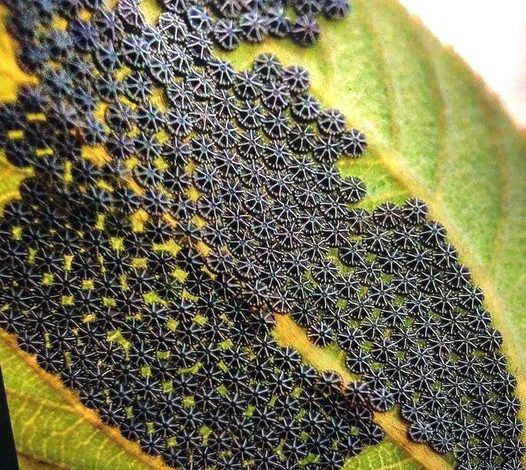Being a gardener is a truly rewarding experience. Witnessing the fruits (or should I say, vegetables!) of your labor and the thriving growth of your plants brings immense satisfaction. But let’s be honest, it’s not always sunshine and roses. Pest control is a constant battle, and sometimes it’s hard to distinguish friend from foe in the insect world.
Recently, a social media image sparked my curiosity – a leaf covered in tiny, intricate black geometric patterns. It looked almost like an alien lattice or a strange plant disease! Like many others, I was initially alarmed. But upon closer inspection, the truth emerged – these fascinating patterns were none other than the eggs of Nymphalis Antiopa butterflies.
The Enchanting Mourning Cloak Butterfly

If you’re unfamiliar with this captivating species, allow me to introduce you to the Mourning Cloak butterfly. With its unique life cycle and intriguing characteristics, it’s a true marvel of nature.
Let’s start with those captivating eggs. In the photo I saw, they resembled a layer of delicate black lace adorning the leaf. While initially surprising, they possess a certain elegance when examined closely. These eggs are laid in clusters, each a testament to nature’s flawless geometric design.
My initial reaction, like many gardeners, was a mix of apprehension and wonder. “Are these beneficial or harmful?” I thought. Thankfully, the news is good!
Friend or Foe? The Positive Impact of Mourning Cloak Butterflies
While the caterpillar stage of the Nymphalis Antiopa enjoys feasting on leaves, they tend to favor willows, elms, and poplars – trees and shrubs most gardeners wouldn’t mind them munching on. So, if your garden is bursting with vegetables and flowers, you can breathe a sigh of relief. In fact, these butterflies can be quite beneficial as they also feed on decaying fruits, aiding in the decomposition process.
The entire metamorphosis of this butterfly is a sight to behold. Once hatched, the eggs transform into spiky black caterpillars with tiny white dots. They progress through several growth stages called “instars,” shedding their skin as they increase in size.
As adults, these caterpillars find a secure location to pupate, forming a chrysalis that resembles a miniature sleeping bag. This stage can last for weeks or even months, depending on the environment and season. Finally, they emerge as the stunning Mourning Cloak butterflies, with their dark, velvety wings adorned with captivating blue spots and a bright yellow border.

Hibernation and the Meaning Behind the Name
One of the most fascinating aspects of the Mourning Cloak butterfly is its winter hibernation behavior. Unlike many other butterfly species, they take shelter under sheds, loose bark, or even in woodpiles during the cold months. They are often among the first butterflies to appear in spring, frequently even before the flowers bloom. Their early arrival, amidst the starkness of the early spring landscape, contributes to their evocative name – “Mourning Cloaks,” as their dark wings resemble a mourning garment.
Finding Balance in Your Garden Ecosystem
As gardeners, we often focus on the immediate impact insects have on our plants. The sight of caterpillars can send shivers down our spines, fearing they’ll devour everything in their path. However, it’s crucial to take a step back and appreciate the bigger picture.
The Nymphalis Antiopa butterfly serves as a perfect example of nature’s intricate balance. While the caterpillars may consume some leaves, they won’t cause complete devastation to your garden. In fact, by providing a habitat for these butterflies, you’re contributing to a healthy ecosystem.

So What Should You Do?
If you discover these caterpillars or eggs in your garden, my advice is to leave them be. Embrace the process and witness the transformation firsthand! If you’re particularly concerned about your prized blooms, you can carefully relocate the caterpillars to a nearby tree or shrub where they’ll be content and less likely to nibble on your precious plants.
The Key to Gardening: Harmony and Exploration
Gardening is all about achieving a harmonious balance with the creatures that share your space and the plants you cherish. The next time you spot something unusual in your garden, take a moment to investigate before reaching for the pesticide. As with my discovery of the Nymphalis Antiopa butterfly eggs, you might just uncover something truly remarkable.
Remember, every element in your garden plays a part in the grand adventure. The bounty and challenges of each season are what make gardening such a fulfilling and enriching experience.

